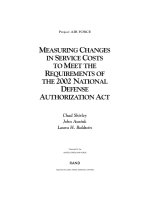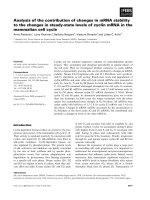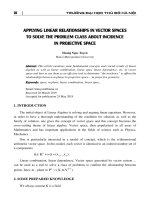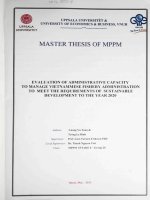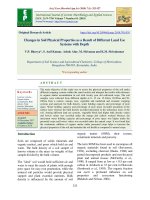Measuring Changes in Service Costs to Meet the Requirements of the 2002 ppt
Bạn đang xem bản rút gọn của tài liệu. Xem và tải ngay bản đầy đủ của tài liệu tại đây (162.98 KB, 53 trang )
Project AIR FORCE
R
Prepared for the
UNITED STATES AIR FORCE
Approved for public release; distribution unlimited
Chad Shirley
John Ausink
Laura H. Baldwin
M
EASURING
C
HANGES
IN
S
ERVICE
C
OSTS
TO
M
EET THE
R
EQUIREMENTS OF
THE
2002 N
ATIONAL
D
EFENSE
A
UTHORIZATION
A
CT
The RAND Corporation is a nonprofit research organization providing
objective analysis and effective solutions that address the challenges
facing the public and private sectors around the world. RAND’s
publications do not necessarily reflect the opinions of its research clients
and sponsors.
R
®
is a registered trademark.
© Copyright 2004 RAND Corporation
All rights reserved. No part of this book may be reproduced in any form
by any electronic or mechanical means (including photocopying,
recording, or information storage and retrieval) without permission in
writing from RAND.
Published 2004 by the RAND Corporation
1700 Main Street, P.O. Box 2138, Santa Monica, CA 90407-2138
1200 South Hayes Street, Arlington, VA 22202-5050
201 North Craig Street, Suite 202, Pittsburgh, PA 15213-1516
RAND URL: />To order RAND documents or to obtain additional information, contact
Distribution Services: Telephone: (310) 451-7002;
Fax: (310) 451-6915; Email:
The research reported here was sponsored by the United States Air Force
under Contract F49642-01-C-0003. Further information may be
obtained from the Strategic Planning Division, Directorate of Plans, Hq
USAF.
Library of Congress Cataloging-in-Publication Data
Shirley, Chad.
Measuring changes in service costs to meet the requirements of the 2002 National
Defense Authorization Act / Chad Shirley, John Ausink, Laura H. Baldwin .
p. cm.
Includes bibliographical references.
“MR-1821.”
ISBN 0-8330-3516-9 (pbk. : alk. paper)
1. Defense contracts—United States. 2. United States. Dept. of Defense—
Appropriations and expenditures. I. Ausink, John A. II. Baldwin, Laura H., 1967–
III.Title.
UC267.S53 2004
355.6'212—dc22
2003027443
iii
PREFACE
Requirements in the 2002 National Defense Authorization Act set
goals for the Department of Defense (DoD) to achieve savings in
service contract expenditures over a ten-year period. This report dis-
cusses the complexities of, and recommends a methodology for,
measuring changes in service costs incurred by the military. The re-
search is a product of the study, “Supporting the Warfighter Through
Improved Service Contracts,” sponsored by the Deputy Assistant
Secretary for Contracting (SAF/AQC) and conducted within the
Resource Management Program of RAND Project AIR FORCE.
For almost a decade, the RAND Corporation has been helping the
Department of Defense improve the way it purchases goods and
services. Readers may also be interested in selected related studies:
• Defining Needs and Managing Performance of Installation
Support Contracts: Perspectives from the Commercial Sector,
Laura H. Baldwin and Sarah Hunter, RAND Corporation, MR-
1812-AF, forthcoming
• Implementing Performance-Based Services Acquisition (PBSA):
Perspectives from an Air Logistics Center and a Product Center,
John Ausink, Laura H. Baldwin, Sarah Hunter, and Chad Shirley,
RAND Corporation, DB-388-AF, 2002, which can be downloaded
from www.rand.org/publications/DB/DB388
• Implementing Best Purchasing and Supply Management
Practices: Lessons from Innovative Commercial Firms, Nancy Y.
Moore, Laura H. Baldwin, Frank Camm, and Cynthia R. Cook,
iv Measuring Changes in Service Costs
RAND Corporation, DB-334-AF, 2002, which can be downloaded
from www.rand.org/publications/DB/DB334
• Federal Contract Bundling: A Framework for Making and
Justifying Decisions for Purchased Services, Laura H. Baldwin,
Frank Camm, and Nancy Y. Moore, RAND Corporation, MR-
1224-AF, 2001, which can be downloaded from
www.rand.org/publications/MR/MR1224
• Performance-Based Contracting in the Air Force: A Report on
Experiences in the Field, John Ausink, Frank Camm, and Charles
Cannon, RAND Corporation, DB-342-AF, 2001, which can be
downloaded from www.rand.org/publications/DB/DB342
• Strategic Sourcing: Measuring and Managing Performance, Laura
H. Baldwin, Frank Camm, and Nancy Y. Moore, RAND
Corporation, DB-287-AF, 2000, which can be downloaded from
www.rand.org/ publications/DB/DB287
• Incentives to Undertake Sourcing Studies in the Air Force, Laura
H. Baldwin, Frank Camm, Edward G. Keating, and Ellen M. Pint,
RAND Corporation, DB-240-AF, 1998
• Strategic Sourcing: Theory and Evidence from Economics and
Business Management, Ellen M. Pint and Laura H. Baldwin,
RAND Corporation, MR-865-AF, 1997.
RAND PROJECT AIR FORCE
RAND Project AIR FORCE (PAF), a division of the RAND Corporation,
is the U.S. Air Force’s federally funded research and development
center for studies and analyses. PAF provides the Air Force with in-
dependent analyses of policy alternatives affecting the development,
employment, combat readiness, and support of current and future
aerospace forces. Research is performed in four programs: Aero-
space Force Development; Manpower, Personnel, and Training;
Resource Management; and Strategy and Doctrine.
Additional information about PAF is available on our web site at
/>v
CONTENTS
Preface iii
Figure vii
Tables ix
Summary xi
Acknowledgments xv
Acronyms xvii
Chapter One
INTRODUCTION 1
Chapter Two
METHODOLOGY TO MEASURE CHANGES IN COSTS
OVER TIME 7
Step 1: Defining the Universe of Services 8
Data on Obligations: The DD350 9
Base-Year Cost Calculation 10
Step 2: Measuring Changes in Service Costs over Time 10
Scope 11
Quantity 12
Quality 14
Data on Current-Year Costs 16
Step 3: Calculating Following-Year Costs 16
Data on Future Expenditures 17
Translating Planning Data into Service Cost
Estimates 17
vi Measuring Changes in Service Costs
Step 4: Calculating That Which “Would Otherwise Be
Expended” 18
Step 5: Determining if the Savings Goal Has Been
Achieved 21
An Illustrative Example of Savings Calculations 21
Improving Savings Measurement Accuracy by Capturing
Changes in the Cost of Unstable Services 22
Chapter Three
SUMMARY AND CONCLUSIONS 25
Postscript 27
Appendix
PLANNING DATA—THE PLANNING, PROGRAMMING,
AND BUDGETING SYSTEM (PPBS) 29
REFERENCES 33
vii
FIGURE
A.1. POM Year Schedule 31
ix
TABLES
S.1. Summary of Reporting Requirements and
Recommendations xiii
1.1. Steps to Estimate Service Cost Savings 4
2.1. Recommendations for Step 1 11
2.2. Recommendations for Step 2 16
2.3. Recommendations for Step 3 19
2.4. Recommendations for Step 4 20
2.5. Sample Savings Calculation 22
2.6. Recommendations for Step 5 22
2.7. Illustrative Example of the Importance of Unstable
Services for Productivity Savings Estimates 24
3.1. Summary of Recommendations 26
xi
SUMMARY
The National Defense Authorization Act for Fiscal Year 2002 sets
forth a series of goals for the Department of Defense to reduce the
cost of the services it buys over a ten-year period through changes in
contracting practices and improvements in management tech-
niques. This study investigates ways to measure whether the Air
Force is achieving these cost-reduction goals and discusses the most
important steps in the measurement process.
Successfully estimating changes in service costs over time first re-
quires establishing a baseline, i.e., expenditures that occurred in the
base year, for a clear universe of services that permits a consistent
comparison of service purchases over time. The second step in the
process is to estimate the expenditures on these services for the cur-
rent fiscal year. A fundamental part of constructing the current-year
expenditures is to control for any changes in the nature of services
purchased over time, including changes in the scope of services, and,
to the extent possible, changes in quantity and quality. The next step
is to apply an appropriate measure of inflation to the baseline ex-
penditures to estimate what those services would have cost in the
current year in the absence of changes in contracting practices and
management techniques. After the baseline, current year, and with-
out-management-change costs have been estimated, the final step is
to calculate the savings achieved and compare them with the goals.
Reporting requirements of the Act necessitate that the savings mea-
surements not only include historical expenditures but that they also
xii Measuring Changes in Service Costs
forecast future expenditures.
1
In fact, what is most difficult about
satisfying the requirements of the Act is that forecasted expenditures
are more important than historical expenditures: the final report re-
quired by the Act in March 2006 is supposed to estimate savings five
years into the future, but it need not address whether the savings
goals of earlier fiscal years were achieved.
Existing data sources offer either a detailed accounting of past ser-
vice purchases or a more general forecast of future purchases, but no
single source is sufficient for the entire task without further work or
linkage.
Table S.1 presents each element of the legislative requirement, the
potential source(s) of data to meet the requirement, and summarizes
our recommendations on how best to implement each element.
While this research recognizes the difficulties inherent in systemati-
cally tracking and analyzing the effects of changes in practices on
service costs, it highlights a general need for improvements in Air
Force data collection and processing to better provide such capabil-
ity. Other RAND research is exploring the adequacy of the DD350
data to identify a stable set of services over time and robustly charac-
terize the Air Force’s service expenditures.
______________
1
The annual report requires not only an estimate of savings in the current year that
resulted from new management practices but also an estimate of savings for the next
year deriving from new management practices.
Summary xiii
Table S.1
Summary of Reporting Requirements and Recommendations
Steps to Estimate Service
Cost Savings
Potential
Data
Source(s) Implementation Recommendations
1. Establish FY00 cost
savings baseline for
procurement of services.
DD350
A. Clearly define the universe of services
governed by the Act; choose a set of
services for which PBSA
a
and other
management innovations are
appropriate.
B. Sum FY00 expenditures for chosen
services.
(See p. 7)
2. Estimate the amount that
will be expended for
procurement of services
in the current FY.
DD350
ABIDES
b
A. Adjust for changes in scope.
B. Where possible, adjust for changes in
the quantity of services purchased.
C. Assume that the quality remains
constant instead of attempting to
adjust prices for quality changes.
(See p. 10)
3. Estimate the amount that
will be expended for
procurement of services
in the following FY.
c
ABIDES A. Establish a link between PSC/NAICS
d
codes in DD350 and EEIC
e
codes in
ABIDES.
B. Use most current forecast for next FY
expenditures for chosen services,
adjusted as described above.
(See p. 16)
4. Establish the
“hypothetical”
expenditures for the
current and following FYs
(the amount that
“otherwise would have
been spent”).
DD350
OSD O&M
f
Price Index
BLS
g
National
Service
Wage
Index
A. Establish the hypothetical cost for the
current year by adjusting the base
year expenditures to current year
dollars through the chosen inflation
index.
B. Do the same for the following FY.
(See p. 18)
xiv Measuring Changes in Service Costs
Table S.1—continued
5. Estimate the amount of
savings in the current FY
and following FY that
result from improved
management practices.
A. Subtract expected expenditures for
the current FY from the hypothetical
for the current FY.
B. Do the same for the following FY.
(See p. 21)
a
Performance-Based Services Acquisition.
b
Automatic Budget Interactive Data Environment System.
c
For the final report, the forecast is for five years into the future.
d
Product Service Code/North American Industry Classification System.
e
Element of Expense/Investment Code.
f
Office of the Secretary of Defense Operation and Maintenance.
g
Bureau of Labor Statistics.
xv
ACKNOWLEDGMENTS
We wish to acknowledge Col Robert Winiecki and Ms. Betsy Matich
of SAF/AQCP for their direction in formulating the scope of this
work; David McNicol of OSD/PA&E for his insightful comments at
the 2002 Western Economics Association Meetings in Seattle; and the
members of the Office of the Secretary of Defense Integrated Process
Team for their thoughts and reactions to an earlier version of this
work.
We also wish to thank our RAND colleagues: Gary Massey and Jack
Graser for their assistance with understanding ABIDES; Bob Roll for
his insights on the PPBS process and for encouraging us to broaden
the methodology to include unstable services; and participants in the
Payday seminar series.
Finally, we thank our RAND colleague Lloyd Dixon and Chip Franck
of the Naval Postgraduate School for their helpful reviews of an early
draft of this report.
xvii
ACRONYMS
A&AS Advisory and Assistance Services
ABES Amended Budget Estimation Submission
ABIDES Automatic Budget Interactive Data Environment
System
APB Amended President’s Budget
BES Budget Estimation Submission
BLS Bureau of Labor Statistics
CFR Code of Federal Regulations
DD350 Department of Defense Form 350
DEPPS Defense Employment and Purchase Projection System
DoD Department of Defense
DRU Direct Reporting Unit
EEIC Element of Expense/Investment Code
F&FP Force and Financial Plan
FOA Forward Operating Agency
FY Fiscal Year
FYDP Future Years Defense Program
FAR Federal Acquisition Regulations
GAO General Accounting Office
GDP Gross Domestic Product
IPT Integrated Process Team
xviii Measuring Changes in Serices Costs
MAJCOM Major Command
NAICS North American Industry Classification System
O&M Operation and Maintenance
OSD Office of the Secretary of Defense
PB President’s Budget
PBSA Performance-Based Services Acquisition
PPBS Planning, Programming, and Budgeting System
POM Program Objective Memorandum
PSC Product Service Code
SCA Service Contract Act
1
Chapter One
INTRODUCTION
Federal agencies purchase a wide range of goods and services each
year. During the 1990s, services became an increasingly important
spending category. In fiscal year (FY) 2000, the federal government
spent more than $87B on services, representing 24 percent growth
(in constant dollars) from FY90. Services currently represent the
largest category of government purchases. The Department of
Defense (DoD) spends more on services than any other federal
agency, in excess of $53B in FY00.
1
The DoD has long sought to ensure that its appropriations are used
as effectively and efficiently as possible. Acquisition reform—en-
compassing a wide range of changes to procurement regulations,
policies, and practices—first focused in the 1990s on the purchase of
weapon systems and other hardware. However, as services have
grown in budgetary importance, acquisition reform for service pur-
chases has become a priority.
One tenet of services acquisition reform is the use of performance-
based contracts. Part 37 of the Federal Acquisition Regulations (FAR)
defines four requirements of a performance-based service contract:
(1) tell the contractor what is needed, rather than how to provide the
service; (2) establish measurable performance standards and a qual-
ity assurance plan to determine whether the service meets the con-
tract requirements; (3) reduce fee or price when the service does not
meet those requirements (negative incentives); and (4) use perfor-
mance (positive) incentives where appropriate. The combination of
______________
1
For more details, see GAO (2001, 2002) and Davis (2001).
2 Measuring Changes in Service Costs
an outcome orientation and focus on incentives is meant to promote
service innovation and reduce costs.
Performance-based service contracts gained attention in the federal
government in the early 1990s (OFPP, 1991). The Air Force issued an
instruction for implementing performance-based service contracts
in 1999 (U.S. Air Force, 1999). In April 2000, Dr. Jacques Gansler, the
Under Secretary of Defense for Acquisition and Technology, estab-
lished a goal that a minimum of 50 percent of DoD service acquisi-
tions, measured in both dollars and contracts, be performance-based
by the year 2005 (Gansler, 2000). The Office of Management and
Budget affirmed the use of performance-based contracts across the
federal government in a March 2001 memorandum by establishing
an interim goal that 20 percent of FY02 federal service contract dol-
lars be awarded through performance-based contracts (O’Keefe,
2001). Most recently, the National Defense Authorization Act for
Fiscal Year 2002 prohibits the use of service contracts in the DoD that
are not performance-based without prior approval.
2
Unfortunately, fundamental changes in practices rarely happen
simply as a result of a policy change. A number of case studies of
DoD and other federal agencies’ recent services acquisition activities
have revealed problems with service contract management, as
agencies struggle with acquisition planning, defining requirements,
evaluating prices, and managing contractor performance. These
problems led the General Accounting Office (GAO) to designate con-
tract management as a “high-risk” area for the DoD and the Depart-
ment of Energy, the next largest purchaser within the federal
government (GAO, 2001).
To encourage the DoD to fundamentally change the way it ap-
proaches its services acquisition activities, the National Defense
Authorization Act for Fiscal Year 2002 (hereafter “the Act”) includes a
requirement to demonstrate ten percent savings in service contract
costs (relative to a baseline of FY00 costs) by FY11 through use of
______________
2
However, the definition of “performance-based” in the Act is different from the one
in FAR Part 37. The Act specifies that a performance-based contract “includes the use
of performance work statements that set forth contract requirements in clear, specific,
and objective terms with measurable outcomes.” See Section 801.2330a.
Introduction 3
performance-based service contracts, increased competition, and
management innovations.
[T]he Department of Defense shall have goals to use improved
management practices to achieve, over 10 fiscal years, reductions in
the total amount that would otherwise be expended by the
Department for the procurement of services (other than military
construction) in a fiscal year by the amount equal to 10 percent of
the total amount of the expenditures of the Department for fiscal
year 2000 for procurement of services (other than military
construction), as follows:
A. By fiscal year 2002, a three percent reduction.
B. By fiscal year 2003, a four percent reduction.
C. By fiscal year 2004, a five percent reduction.
D. By fiscal year 2011, a ten percent reduction.
3
The DoD must also report estimates of savings to Congress annually
through 2005, including, at a minimum, the following information:
4
• A summary of steps taken or planned to be taken in the fiscal
year of the report to improve management of procurement of
services.
• A summary of such steps planned for the following fiscal year.
• An estimate of the amount DoD will spend on the procurement
of services in the fiscal year of the report.
• An estimate of these expenditures for the following fiscal year.
• An estimate of the amount of savings that will be achieved as a
result of improved management practices, both in the fiscal year
of the report and in the following fiscal year.
The first report was due March 1, 2002, but DoD was unable to meet
the deadline. The final report is due March 1, 2006—even though the
______________
3
See the National Defense Authorization Act for Fiscal Year 2002, Section 802,
“Savings Goals for Procurements of Services.”
4
Section 802(b) paraphrased; emphasis added.
4 Measuring Changes in Service Costs
goals for reductions in expenditures extend through 2011.
5
Each re-
port must include both realized savings to date and an estimate of
future year savings.
6
The final report forecasts these savings out five
years.
Measuring these changes in services acquisition costs over time both
accurately and fairly is a difficult task, and is made even more com-
plicated by the need to project estimates into the future to meet the
reporting requirements. In Table 1.1 we break down the process of
estimating the savings into a series of steps.
The first step is to define the set of services for which costs will be
measured over time and calculate the cost savings baseline, the
amount spent on those services in FY00. This baseline determines
the cost reduction goal. The second step is to determine the amount
spent on the set of services in the current year (i.e., costs “with man-
agement improvements”), and the third (because of reporting
requirements of the Act) is to estimate the amount to be spent in the
following year. The second and third steps will require a methodol-
ogy to control for changes in the services purchased over time. The
fourth step is to estimate the amounts that would have been spent in
Table 1.1
Steps to Estimate Service Cost Savings
1. Establish FY00 cost savings baseline for procurement of services.
2. Estimate the amount that will be expended with management improvements for
procurement of services in the current FY.
3. Estimate the amount that will be expended with management improvements for
procurement of services in the following FY.
4. Estimate expenditures without management improvements for the current and
following FYs (the amount that “would otherwise be expended”).
5. Estimate the amount of savings in the current FY and following FY that result
from improved management practices. Compare with cost savings goal.
______________
5
Note that there is no requirement to report on whether goals in previous years were
actually achieved, nor is there any sanction for failure to achieve any of the goals.
6
The estimated savings for the following year is probably meant to provide an early
indication of progress toward meeting the following year’s savings goals.
Introduction 5
the current year and in the following year in the absence of any im-
provements in the management of services procurement activities
(i.e., costs “without management improvements”). This step will re-
quire the development of an acceptable estimation approach. The
fifth and final step is to compare the amounts without management
improvements with the current year and future year expenditures
with management improvements to determine the level of savings
and thus whether the cost reduction goal is met.
The purpose of this report is to support the Air Force’s efforts to meet
the cost reduction goals and reporting requirements established by
the Act. Specifically, we outline a methodology to measure changes
in service contract costs over time, and we discuss challenges associ-
ated with implementing this methodology (including finding ade-
quate data sources) and complying with the Act’s reporting require-
ments.
The remainder of this report is organized as follows. Chapter Two
describes a methodology the Air Force can use to measure changes
in service contract costs over time, following the steps outlined in
Table 1.1. It discusses the need to identify a set of services relevant to
the cost savings goal, i.e., which service costs should be measured
over time. It examines a number of issues associated with measuring
service contract expenditures with management improvements, and
it explores methodologies to calculate the amount that “would oth-
erwise be expended” for services if improved management practices
had not been implemented. Data issues are discussed along the way.
Chapter Three then provides a summary and a discussion of remain-
ing issues.
7
Chapter Two
METHODOLOGY TO MEASURE CHANGES
IN COSTS OVER TIME
The savings calculation presented in the previous chapter raises a
number of analytic questions:
• What activities are considered services for the purpose of com-
plying with the Act?
• How should cost changes be measured over time?
• How should these cost changes be projected into the future?
• How is what “would otherwise be expended” to be determined?
• What savings are realized, and do they meet the goal?
In this chapter, we discuss issues related to each and suggest ap-
proaches that the Air Force can take to satisfy the intent of the Act.
In this research, we considered two approaches to meeting the re-
porting requirements of the Act. In one approach, the Air Force
would consider a random sample of service contracts. To estimate
the savings from each contract, the Air Force would need to explore
the nature of the services purchased over time, their past and current
costs, and their expected future costs. Statistical techniques would
then be used to apply the results of the random sample to the entire
population. A second approach is to aggregate expenditures for ser-
vices and estimate savings for the populations using projections and
statistical techniques.
We chose to focus on the latter approach. While collecting data on a
subset of contracts initially appears more feasible, it would be ex-

